How Fruits And Vegetables Looked Like Before And After GMO’s
Genetically Modified Organisms are those whose genome has been altered for the desired physiological traits or the biological products of our choice by using genetic engineering techniques. GMOs hence possess distinct attributes that would by no way would have occurred naturally. Some GMOs are produced for laboratory research whereas others are for human consumption.
Agricultural production started some 10,000 years ago and since then farmers have changed the genetic makeup of plants and animals applying various techniques. So, as a result of human intervention and selective breeding, almost 90% of crops in the market are genetically altered to foster growth, enhance taste and increase yield. Using genetic engineering techniques, DNA of animals, plants and even microbes can be altered to modify the organisms and offspring.
Where we were using conventional breeding techniques like crossbreeding and selective breeding, the superb advancement in biotechnology has enabled scientists to directly modify the DNA of organisms for developing desired traits.
It has solved the problems of unwanted characteristics emerging as a consequence of mixed results. GMOs are easy to harvest and provide higher returns to farmers while encountering the food shortage problems. This makes food available at a low price and of higher quality and taste. However, some threats to unexpected allergies still remain. So, GMOs are well tested and are subject to rigorous safety assessments and regulations.
Since 2012, when the first GMO Salomon fish got approved for human consumption, no health effect in consumers are observed. The modification process starts by identifying the desired trait and seeking genes in other plants, animals or microbes they want the to-be-modified organism to exhibit. Once the specific gene controlling the desired trait is isolated, it is transferred to the organism to be modified.
The genetically modified crops have genes that are artificially inserted through the techniques of biotechnology instead of those they acquire through pollination. Some of the genetically modified crops are listed here.
Wild Watermelon
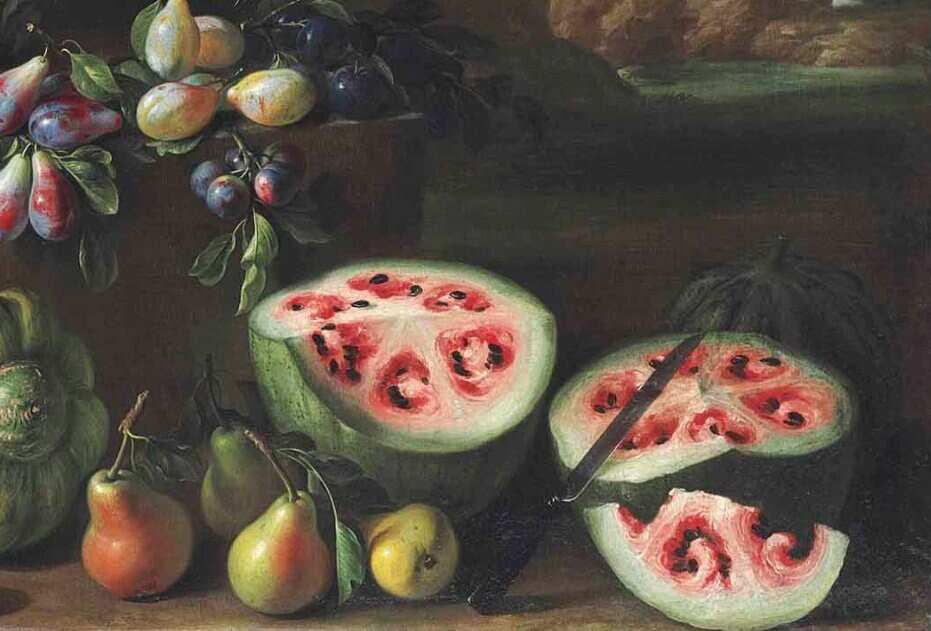
The tropical plant has been around for millennia but in a completely different form that it is today. The refreshing fruit soaked with an abundance of nutritious elements used to have more seeds than we have in modern watermelon. It used to be paler with less red flesh.
With the native range extending from Northern Africa to West India, watermelon has now reached every corner of the world serving as the juiciest and the most exhilarating fruit full of health benefits. Archaeologists discovered watermelon seeds in 5,000 years old settlement in Libya and in 4,000 years old Egyptian tombs. The paintings of that period revealed a completely different shaped and distinct interior flesh.
Further, a cross-section of painting from the 17th century by Giovanni Stanchi exhibit watermelon with swirly shape embedded in six triangular pie-shaped pieces. They used to be of bitter taste or just bland. Some used to be sweeter which were domesticated and the selective breeding among several cultures and countries caused the melon to be popular fruit for all occasions.
Hebrew writing of around 200 AD has placed the watermelon in the same category as grapes and pomegranates and the profound sweetness is common for them all. So, watermelon changed from desert fruit to dessert variety with time.
Modern Watermelon
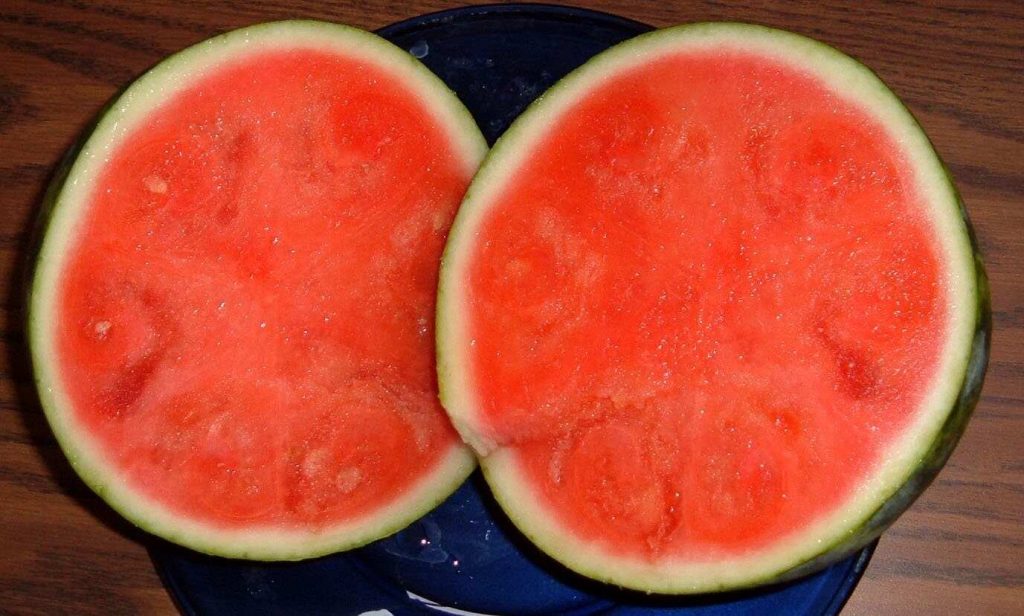
Watermelon has changed dramatically due to careful breeding than it was three centuries ago. The ancestral watermelons used to be of 2 inches weighing three ounces whereas modern ones can even be of two feet.
The weird-looking whitish flesh and heavily gathered seeds are replaced by juicy red flesh and sparely scattered seeds. A chemical known as colchicine derived from crocuses causes a watermelon to be seedless doubling the number of chromosomes.
The seedless watermelon is produced by back-crossing a doubled watermelon (tetraploid, having four sets of chromosomes) with a normal one (diploid, having two sets of chromosomes) which results into triploid, i.e. watermelon having three sets of chromosomes.
Egyptians used to take watermelon as a source of water during long voyages as it could be served even after weeks or months if it is kept in a cool shaded area.
It was believed to have amazing healing properties. The first change people sought in watermelon is its bitter taste. Only one gene was responsible for it so that it was breed out of the population and slowly thereafter, watermelon growers started selectively breeding other traits as per their choice.
Wild Eggplant

The deep purple-colored fruit with whitish or creamy flesh commonly known as aubergine or brinjal has a well-documented past of domestication. It belongs to the Solanaceae family being native to Africa and first domestication being in Asian countries. Researchers have proved that the two distinct lineages of eggplant have dramatically expanded in the last two million years.
There is still some debate among scholars regarding the progenitor plant for Solanum Melongena. Some believe it is descended from African plant S. linnaenum whereas others believe S. incarnum of North Africa and Middle East is from where modern eggplant got in existence.
Literary creations from the 3rd century and multiple references from 59 BC, as well as 300 BC, marks the presence of eggplant that time in a different form.
Rhapsody from 1st century BC to 1st century AD has also mentioned eggplant when it used to be round and small and particularly in green color with much bitter taste then it is now. Chinese botanical references dating between 7th to 19th century documents the change in shape and size of eggplant as well as the search for better flavor. The agricultural book of 12th century in Arabic Spain provides suggestions on how to grow better aubergine.
As aubergine belongs to the nightshade family, its leaves and flowers used to be considered toxic if consumed in large quantity as it contains an alkaloid called solanine.
Modern Eggplant
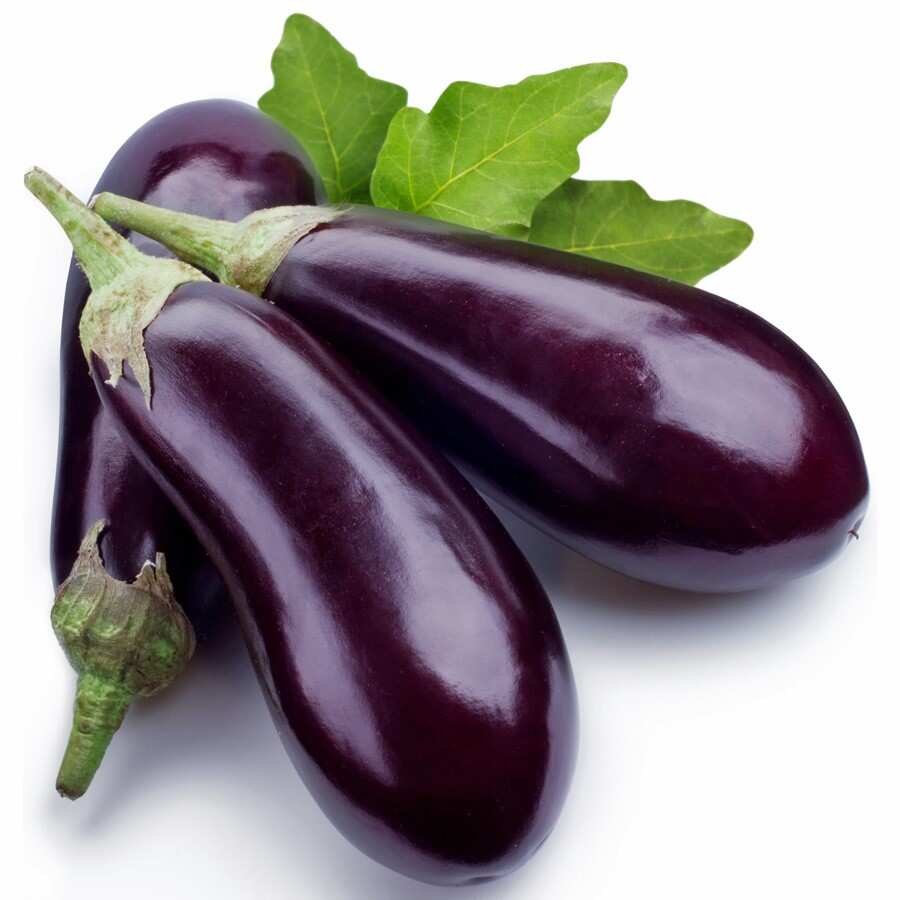
Modern eggplants come in the shades of white, red, purple, striped and magenta and they have fewer seeds as compared to their ancestors. The interior is often creamy or white. As they are mostly harvested young, it is not bitter as it used to be, though its taste depends mostly on how it is cooked and flavored.
Selective breeding has caused it to be slender, long and thin-skinned. Some are of tear shaped as opposed to round progenitor. White eggplants are comparatively smaller with tough skin. Generally, smaller and thinner eggplants have milder flavor as some larger eggplants whose breeds haven’t been still engineered to remove this trait might taste somehow bitter.
The sponge-like texture of eggplant is being diversely used in most of the culinary. It is composed of more than 90% water with high fiber and low calories, high number of antioxidants and rich nutrients like potassium and magnesium. Its bountiful health benefits have made it popular in medical sectors as well.
Wild Carrot
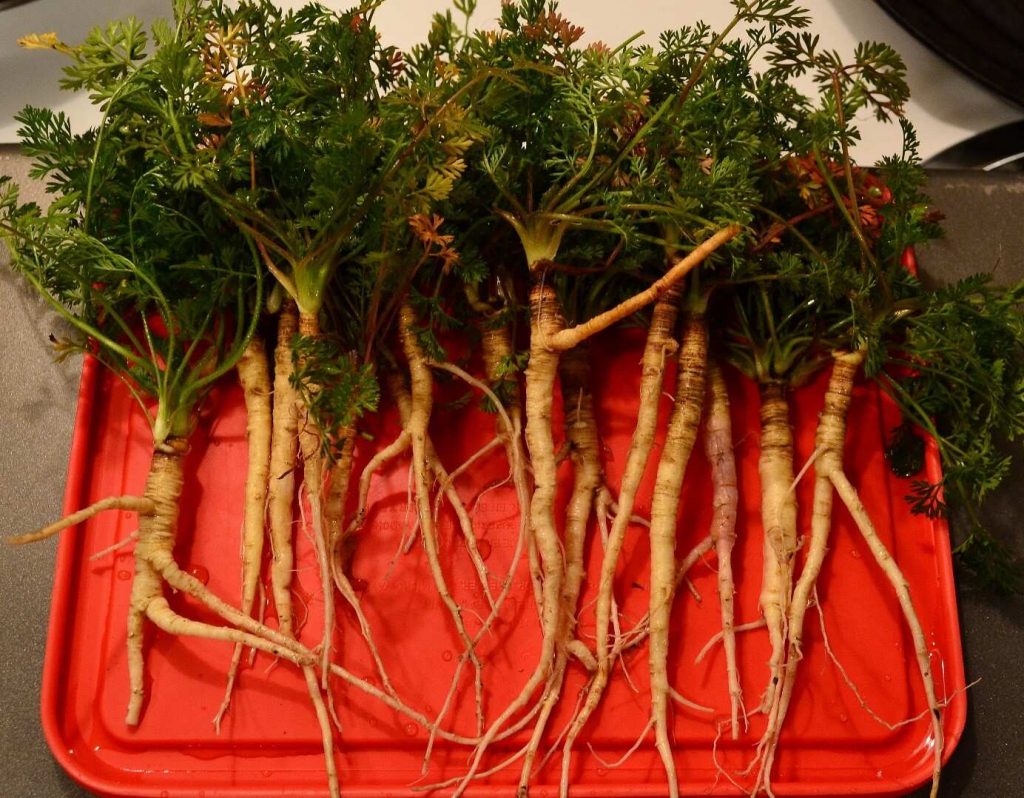
Wild carrot (Daucus Carota) native to the temperate regions of Europe and Southwest Asia were mostly used as a medicinal plant before being domesticated. Unlike modern sweet and pigmented roots, wild carrots used to be bitter, smaller and tougher. The spindly root used to be of purple, yellow or white color and with more hairy branches.
They grow mostly in temperate regions including rough grasslands, coastal cliffs, weedy meadows, and in dunes. Their deep roots make it difficult to extirpate by simple mowing or hand-pulling. It used to be treated as alien species that invade the prairies displacing native plants as it matures faster and grows larger than other plants.
New flower stems get produced throughout the growing season from the basal rosette and once the flowers are pollinated, the umbel closes in on itself and dries out as seeds get matured. It needs vernalization at low temperature to induce flowering. They grow well under full sunlight and is mesic to dry conditions.
It is an outcrossing diploid species having 2n= 18 chromosomes. Wild carrots are still abundant in the United States, Europe and Asia. Their growth and life span are somehow influenced by environmental conditions.
Modern carrots
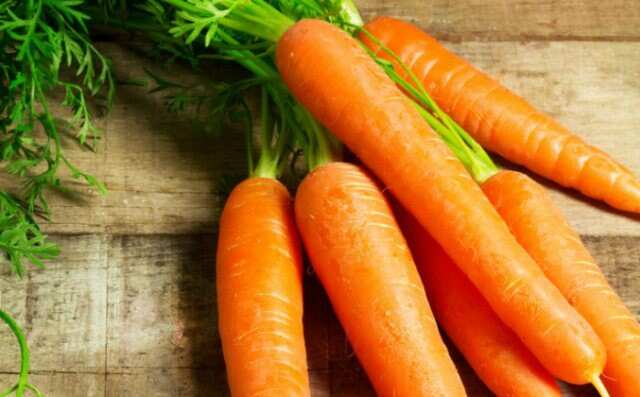
The crunchy and tasty carrots rich in beta-carotene and other carotenoids are the healthiest foods served with every type of dish or in the form of dish in any cuisine.
Two types of carrots are cultivated these days: eastern/ Asiatic (anthocyanin) carrots and western/ carotene carrots. The Eastern carrot is either yellow or purple (ranging from reddish to black). It has greyish-green leaves with little protective hairs. The western one has unbranched roots with yellow, orange, red and occasionally white color.
They are believed to be originated from carrots having purple-colored roots with anthocyanin and yellow mutants lacking anthocyanin. The flowers and leaves are also edible and the root becomes too woody for consumption quickly.
The bicarpellate root/ fruit is often oval or flattened with tripinnate slightly dissected leaves. Paintings from 16th and 17th centuries show red or yellow roots carrots being cultivated in Turkey, North Africa and Spain. It has strongly dissected leaves with bright green color and is sparsely hairy. They may be annual or biennial while the Eastern carrots flowers mostly in the first year.
Because of cosmetic changes in the genes, domestic carrots are less robust than their wild ancestors. Transfer of genome from wild carrots could help make modern carrots more robust.
Wild Banana
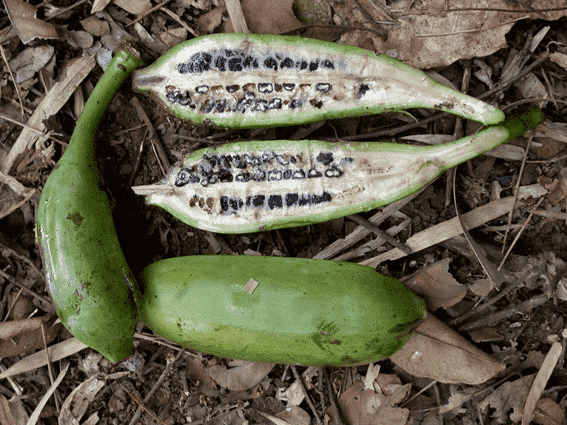
Most of the modern cultivated edible bananas are derived from Musa Acuminata or Musa Balbisiana or the hybrid of both. It has been 7,000 years since the bananas were domesticated as per the archeological evidence obtained in Papua New Guinea. Banana pollen and stem imprints and other sorts of fossils are shown in the record.
Texts from Palestine and Egypt from 10th century include the name banana. Before domestication, bananas used to be full of seeds unlike the modern one with dominance of sweetish pulp. The seeds were hard and the pulp were not so tasty to eat. Wild bananas are diploid like human chromosomes and the offspring receives one from each parent. Those with genetic predisposition and parthenocarpy are credited for modern seedless bananas.
Wild bananas are in the phase of extinction as only five and that too matured trees are left in Madagascar. It is believed to have special properties than of the rest as it has evolved in the island isolated from the mainland. Their larger seeds and resilient genetic make-up would improve modern cultivated banana.
As bananas are clone, diseases can spread very quickly so that they are very vulnerable to pests and fungus. The first bananas were grown in Malaya Peninsula, Indonesia, the Philippines and New Guinea.
Modern Banana

The top-selling fruit is ranked as the fourth most valuable crop in the world with plentiful health benefits. Though modern bananas still have tiny little seeds, they play no role in reproduction.
More than 1,000 varieties of bananas are grown in 150 countries of the world. The most common is the Cavendish among 50 sub-divisions. As they lack genetic diversity, threat of several diseases often prevails.
What comes in your mind on hearing the names ice-cream, Mona Lisa, Burro and Blue Java? Well, they are the name of different varieties of bananas.
The first variety of banana to be cultivated in large scale was Big Mike during 1800 AD in North America and European cities. The one we eat today belonging to triploid AAA group of Musa Acuminata began to develop in Africa around 650 AD.
They grow best in the tropical climate. They thrive better in shaded and moist ravines and marshlands in the altitude above 1,200m. Each plant (herb) produces only one stem of banana in a lifetime holding up to 200 bananas. Around 115 million tons of bananas are produced every year whole over the world.
Wild Corn
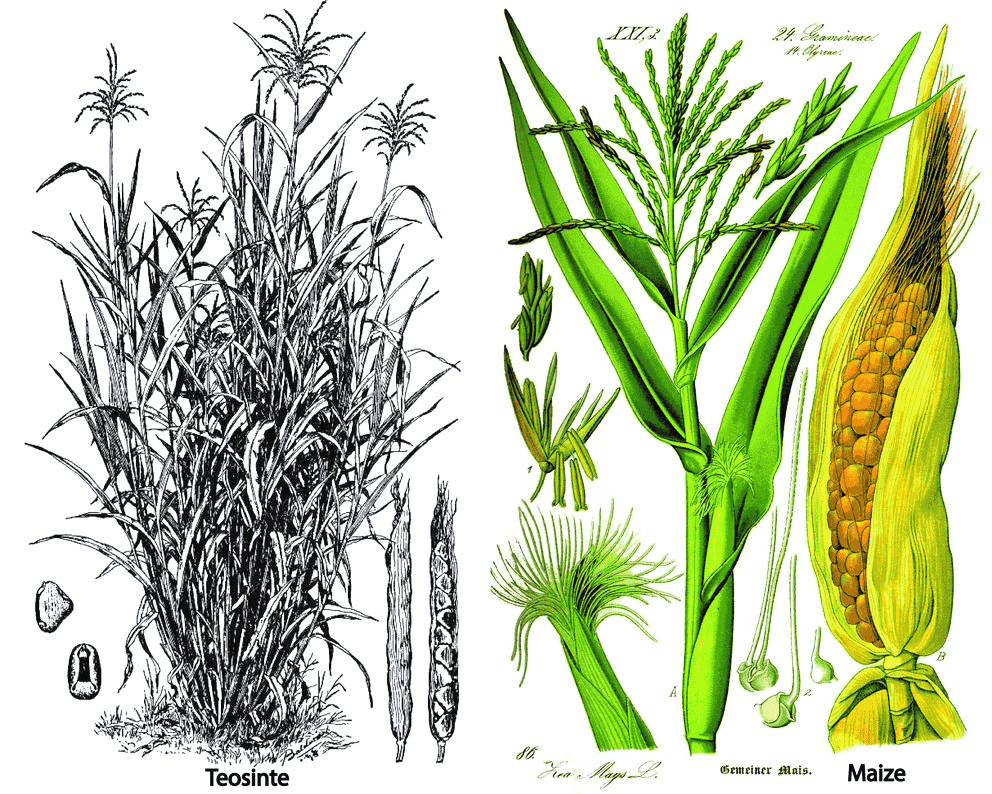
How modern crops look today is in no way similar in looks to the wild ancestor known as a grass called Balas Teosinte especially on comparing the kernels. However, they have the same number of chromosomes and a similar arrangement of genes.
So, scientists have tried cross-breeding teosinte with modern crop and observed the characteristics of offspring. They reached the conclusion that only five genes are responsible for such a massive difference between teosinte and modern maize. The wild grasses grow in central Balsas River valley of Mexico. Even a small change in single gene could have a dramatic effect in the newcomer.
The earliest dated evidence of domestication of the crop is of before 8,700 years. Maize starch gains were discovered on the cracks and crevasses of concave surface of the tool used to grind maize and other crops while excavating the Xihuatoxtla shelter of the Balsas.
A teosinte is just 2-3 inches containing 5-12 kernels. They were encased in hard coating and the paper-thin hard corns were not even worth the effort of breaking the hard shell. They taste like very dry and raw potato. So, people started selective breeding changing the appearance, yield and quality of teosinte.
Modern Corn
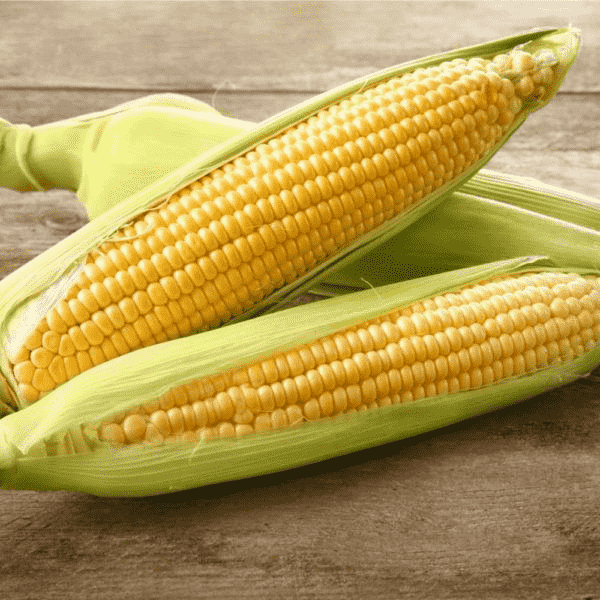
The super-refreshing corn of present is more than 500 times larger than its ancestor and the kernel is easy to peel. Even the stem cooks in minutes giving a juicy and sweet taste. It is the second most important cereal in the world today, after wheat.
It is grown in more than 164 countries with annual production over 1 billion metric ton growing with an average annual rate of 3.46%. The United States accounts for the highest producer and exporter of modern crops claiming 33% of total production around the world. However, very little of this harvest is consumed by human. Rest is for the production of ethanol, animal feed and wider varieties of maize products.
Corns are rich in vitamins, fiber, mineral and antioxidants and act miracle in several health conditions. The favorite summer cookout is rich is natural sugar so it sometimes gets a bad rap. Though the most common is yellow, crops come in other different colors; red, orange, purple, blue, white and even black.
Artificial breeding caused maize to be resilient giving higher resistance to pests, better kernel shape, size and color and ability to grow under different climatic conditions and soil. Maize is an annual plant that dies after reproduction within the growing season in which it is planted.
Wild Peach

Archeologists discovered several peach pits in different sites of lower Yangtze River Valley in Southern China. The well-preserved peach stones of at least 7,000 years back show that the size kept on increasing over the years and its shape kept on changing as well.
Wild peaches (Prunus Mira) have thin and tough flesh and large hard rounded seeds. It is considered a natural hybrid cross between a peach and almond.
The largest peach stone (seed) resembling modern peaches were found dating back somewhere between 3,500 to 4,200 years. And the oldest peach stones discovered till date dates back to 7,500 to 8,000 years before. So, scientists reached the conclusion that the domestication process started more than 7,000 years ago and it took 3,000 years for the peach to evolve from wild species to how it is today.
Wild peaches are small with a rounded base extending roughly 3-4 cm in diameter. The greenish-yellow thin skin develops into a subtle red blush once it gets matured. The pulp is of light yellow color with red stains around the stone in the center.
They have more salty and acidic/ sour taste rather than sweet. The late- summer fruit is mostly used in for making wine and adding flavor to meat and cheese. Oil extracted from kernels are used for cooking, conditioning hair and massaging sore joints.
Modern Peach
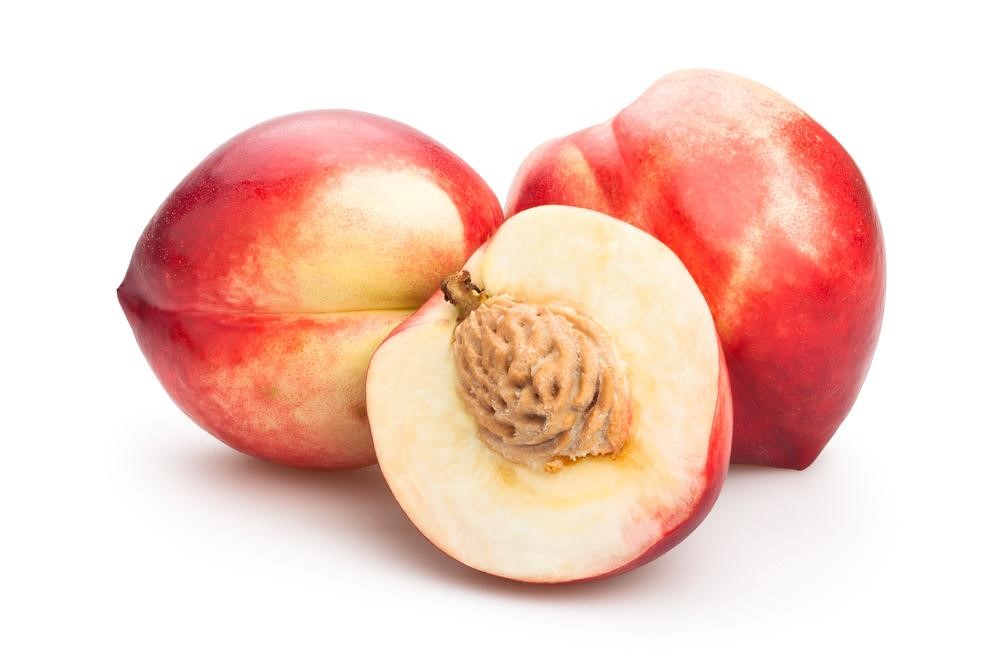
The impossibly delicious artificial peach has reduced stone size with 90% edible flesh. Even the skin is soft and edible. It is comparatively sweet and juicy than its ancestors. The enchanting summer fruit is almost 16 times larger due to selective breeding for thousands of years. The stone is oval-shaped and small, unlike the rounded one of prolific plant.
Peaches are grown over the world now. However, the native mainland China has the greatest genetically diverse varieties of peaches, with 495 recognized cultivars followed by Spain, Italy, Greece and the United States. China only grows more than 14 million tons of peach each year. They thrive best in a dry, continental or temperate climate.
There are two types of peaches grown these days: freestone and clingstone. They support in strengthening the immune system, anti-ageing, improve digestion, smoothen skin and protect the nervous system. The incredibly delicious fruit can be eaten on its own or added to a variety of dishes for superb flavor.
